Report: Managing Customer Experience in the Service Sector for TUI
VerifiedAdded on 2020/10/05
|14
|4037
|364
Report
AI Summary
This report provides a comprehensive analysis of customer experience management within the service sector, using TUI as a case study. It begins by highlighting the significance of understanding customer needs, wants, and preferences, and explores factors influencing customer engagement. The report then delves into customer experience mapping, discussing touchpoints and their impact on the customer journey. Furthermore, it examines the role of digital technology in managing customer experience, providing examples like chatbots and big data analytics. Finally, the report illustrates customer service strategies employed by TUI, demonstrating how they create and develop customer experience to meet customer needs. The report covers various aspects like internal and external factors, the use of digital technologies, and the importance of employee training and motivation in providing excellent customer experience. The report is a valuable resource for understanding customer experience management in the service industry.
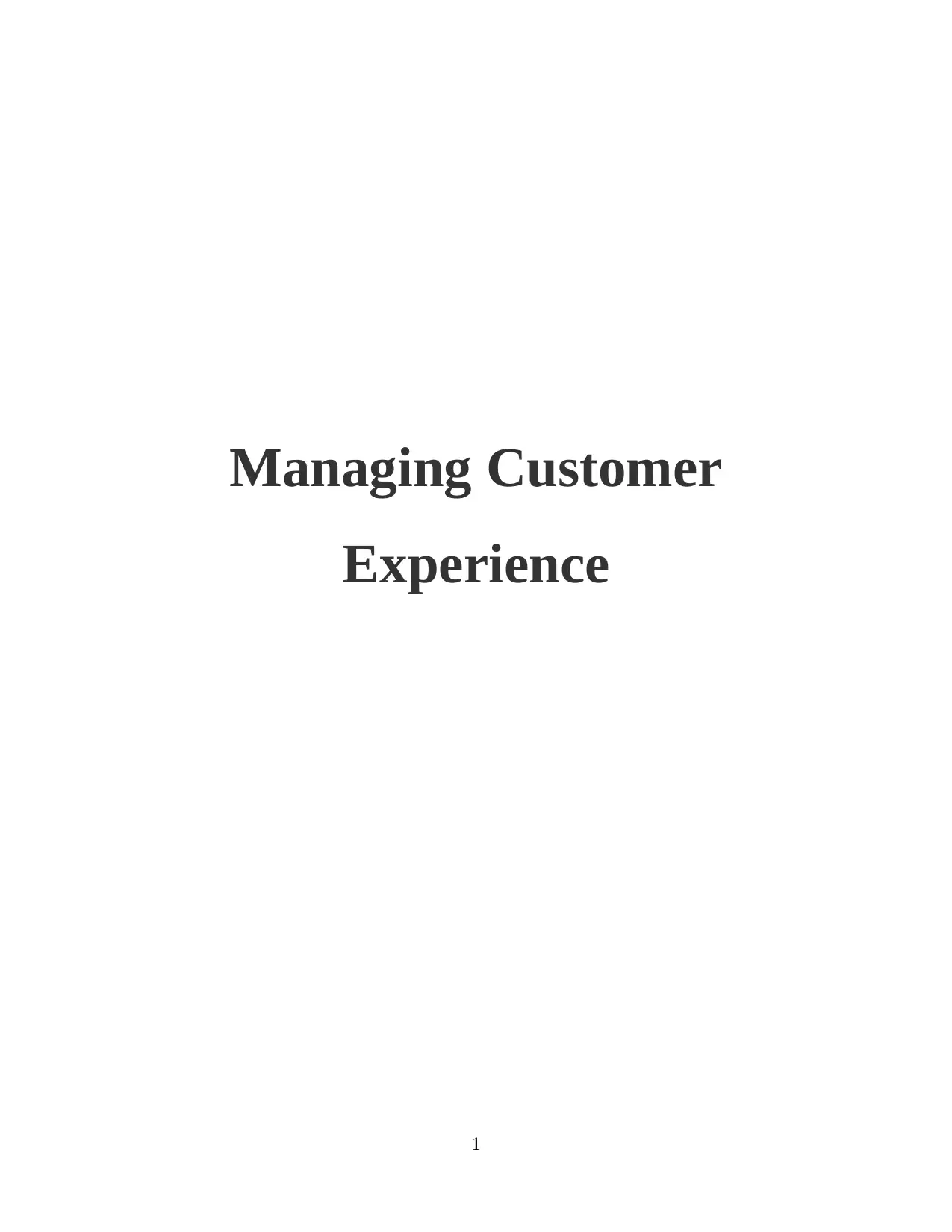
Managing Customer
Experience
1
Experience
1
Secure Best Marks with AI Grader
Need help grading? Try our AI Grader for instant feedback on your assignments.
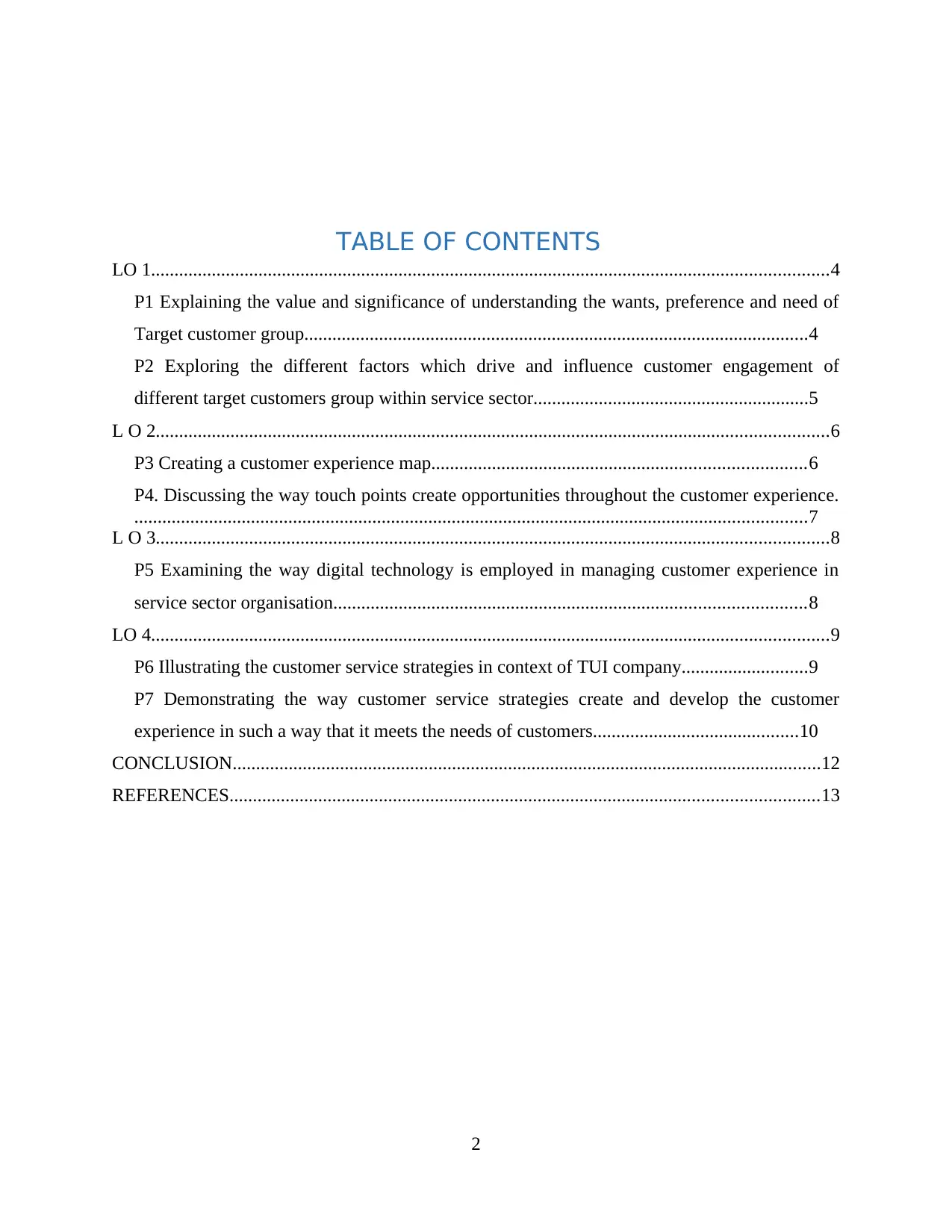
TABLE OF CONTENTS
LO 1.................................................................................................................................................4
P1 Explaining the value and significance of understanding the wants, preference and need of
Target customer group............................................................................................................4
P2 Exploring the different factors which drive and influence customer engagement of
different target customers group within service sector...........................................................5
L O 2................................................................................................................................................6
P3 Creating a customer experience map................................................................................6
P4. Discussing the way touch points create opportunities throughout the customer experience.
................................................................................................................................................7
L O 3................................................................................................................................................8
P5 Examining the way digital technology is employed in managing customer experience in
service sector organisation.....................................................................................................8
LO 4.................................................................................................................................................9
P6 Illustrating the customer service strategies in context of TUI company...........................9
P7 Demonstrating the way customer service strategies create and develop the customer
experience in such a way that it meets the needs of customers............................................10
CONCLUSION..............................................................................................................................12
REFERENCES..............................................................................................................................13
2
LO 1.................................................................................................................................................4
P1 Explaining the value and significance of understanding the wants, preference and need of
Target customer group............................................................................................................4
P2 Exploring the different factors which drive and influence customer engagement of
different target customers group within service sector...........................................................5
L O 2................................................................................................................................................6
P3 Creating a customer experience map................................................................................6
P4. Discussing the way touch points create opportunities throughout the customer experience.
................................................................................................................................................7
L O 3................................................................................................................................................8
P5 Examining the way digital technology is employed in managing customer experience in
service sector organisation.....................................................................................................8
LO 4.................................................................................................................................................9
P6 Illustrating the customer service strategies in context of TUI company...........................9
P7 Demonstrating the way customer service strategies create and develop the customer
experience in such a way that it meets the needs of customers............................................10
CONCLUSION..............................................................................................................................12
REFERENCES..............................................................................................................................13
2

3
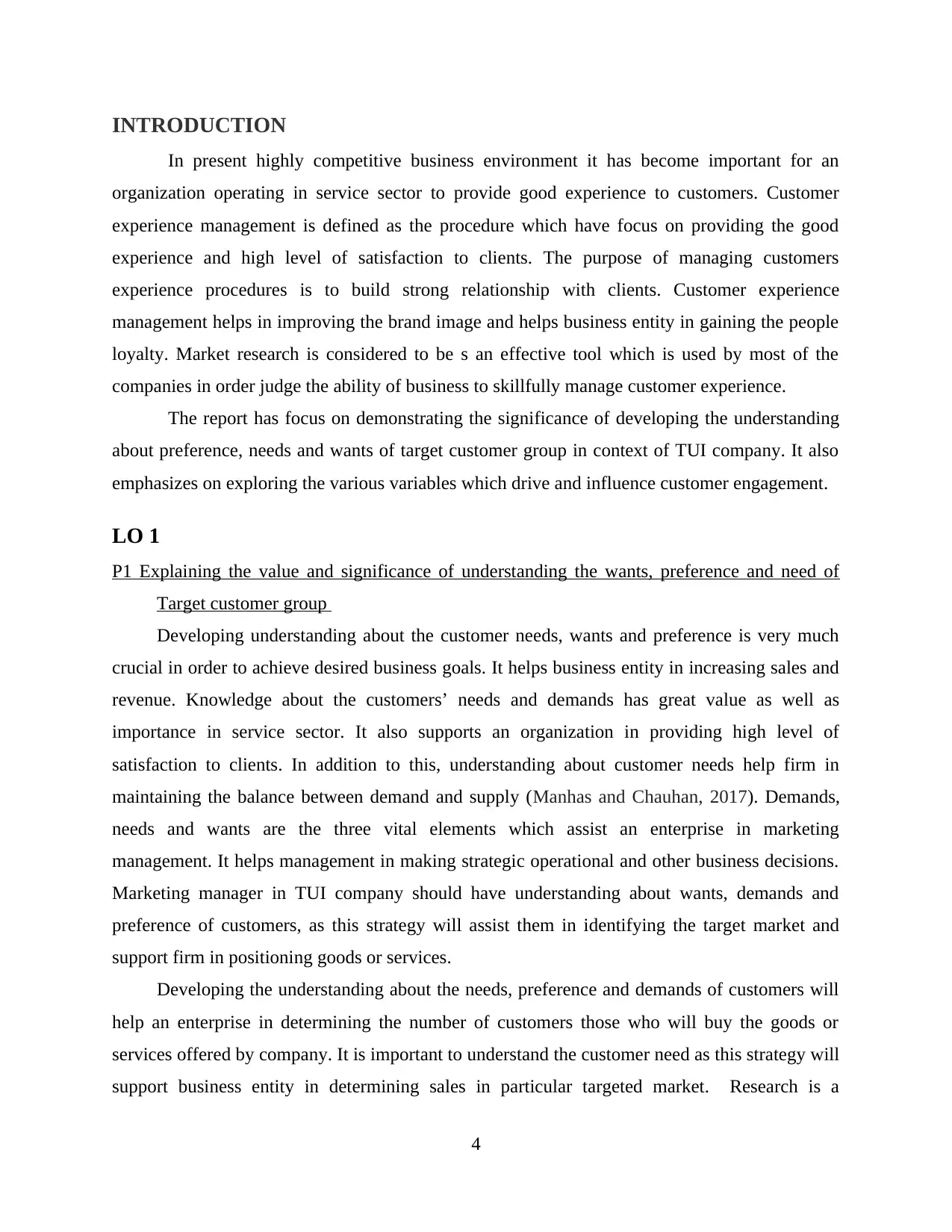
INTRODUCTION
In present highly competitive business environment it has become important for an
organization operating in service sector to provide good experience to customers. Customer
experience management is defined as the procedure which have focus on providing the good
experience and high level of satisfaction to clients. The purpose of managing customers
experience procedures is to build strong relationship with clients. Customer experience
management helps in improving the brand image and helps business entity in gaining the people
loyalty. Market research is considered to be s an effective tool which is used by most of the
companies in order judge the ability of business to skillfully manage customer experience.
The report has focus on demonstrating the significance of developing the understanding
about preference, needs and wants of target customer group in context of TUI company. It also
emphasizes on exploring the various variables which drive and influence customer engagement.
LO 1
P1 Explaining the value and significance of understanding the wants, preference and need of
Target customer group
Developing understanding about the customer needs, wants and preference is very much
crucial in order to achieve desired business goals. It helps business entity in increasing sales and
revenue. Knowledge about the customers’ needs and demands has great value as well as
importance in service sector. It also supports an organization in providing high level of
satisfaction to clients. In addition to this, understanding about customer needs help firm in
maintaining the balance between demand and supply (Manhas and Chauhan, 2017). Demands,
needs and wants are the three vital elements which assist an enterprise in marketing
management. It helps management in making strategic operational and other business decisions.
Marketing manager in TUI company should have understanding about wants, demands and
preference of customers, as this strategy will assist them in identifying the target market and
support firm in positioning goods or services.
Developing the understanding about the needs, preference and demands of customers will
help an enterprise in determining the number of customers those who will buy the goods or
services offered by company. It is important to understand the customer need as this strategy will
support business entity in determining sales in particular targeted market. Research is a
4
In present highly competitive business environment it has become important for an
organization operating in service sector to provide good experience to customers. Customer
experience management is defined as the procedure which have focus on providing the good
experience and high level of satisfaction to clients. The purpose of managing customers
experience procedures is to build strong relationship with clients. Customer experience
management helps in improving the brand image and helps business entity in gaining the people
loyalty. Market research is considered to be s an effective tool which is used by most of the
companies in order judge the ability of business to skillfully manage customer experience.
The report has focus on demonstrating the significance of developing the understanding
about preference, needs and wants of target customer group in context of TUI company. It also
emphasizes on exploring the various variables which drive and influence customer engagement.
LO 1
P1 Explaining the value and significance of understanding the wants, preference and need of
Target customer group
Developing understanding about the customer needs, wants and preference is very much
crucial in order to achieve desired business goals. It helps business entity in increasing sales and
revenue. Knowledge about the customers’ needs and demands has great value as well as
importance in service sector. It also supports an organization in providing high level of
satisfaction to clients. In addition to this, understanding about customer needs help firm in
maintaining the balance between demand and supply (Manhas and Chauhan, 2017). Demands,
needs and wants are the three vital elements which assist an enterprise in marketing
management. It helps management in making strategic operational and other business decisions.
Marketing manager in TUI company should have understanding about wants, demands and
preference of customers, as this strategy will assist them in identifying the target market and
support firm in positioning goods or services.
Developing the understanding about the needs, preference and demands of customers will
help an enterprise in determining the number of customers those who will buy the goods or
services offered by company. It is important to understand the customer need as this strategy will
support business entity in determining sales in particular targeted market. Research is a
4
Secure Best Marks with AI Grader
Need help grading? Try our AI Grader for instant feedback on your assignments.
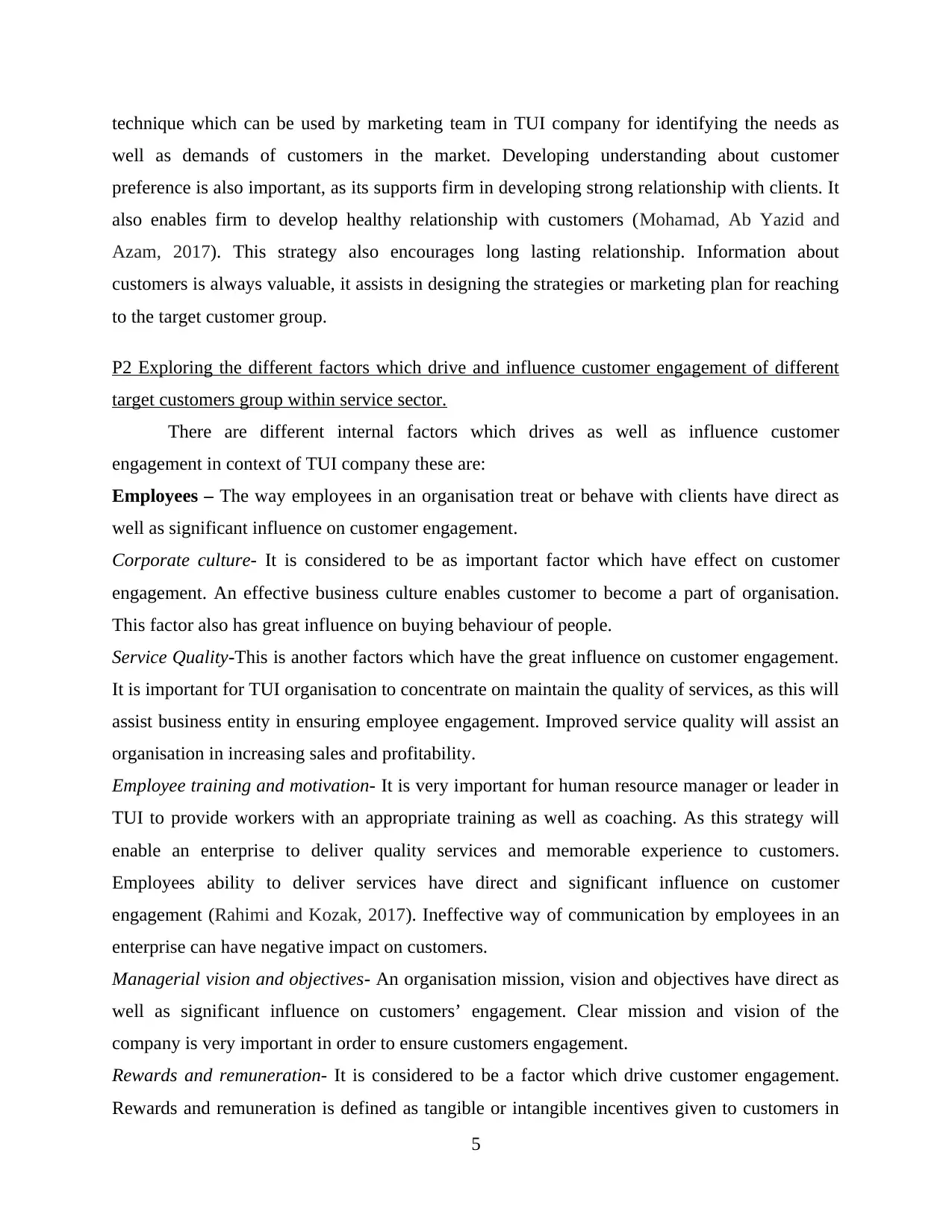
technique which can be used by marketing team in TUI company for identifying the needs as
well as demands of customers in the market. Developing understanding about customer
preference is also important, as its supports firm in developing strong relationship with clients. It
also enables firm to develop healthy relationship with customers (Mohamad, Ab Yazid and
Azam, 2017). This strategy also encourages long lasting relationship. Information about
customers is always valuable, it assists in designing the strategies or marketing plan for reaching
to the target customer group.
P2 Exploring the different factors which drive and influence customer engagement of different
target customers group within service sector.
There are different internal factors which drives as well as influence customer
engagement in context of TUI company these are:
Employees – The way employees in an organisation treat or behave with clients have direct as
well as significant influence on customer engagement.
Corporate culture- It is considered to be as important factor which have effect on customer
engagement. An effective business culture enables customer to become a part of organisation.
This factor also has great influence on buying behaviour of people.
Service Quality-This is another factors which have the great influence on customer engagement.
It is important for TUI organisation to concentrate on maintain the quality of services, as this will
assist business entity in ensuring employee engagement. Improved service quality will assist an
organisation in increasing sales and profitability.
Employee training and motivation- It is very important for human resource manager or leader in
TUI to provide workers with an appropriate training as well as coaching. As this strategy will
enable an enterprise to deliver quality services and memorable experience to customers.
Employees ability to deliver services have direct and significant influence on customer
engagement (Rahimi and Kozak, 2017). Ineffective way of communication by employees in an
enterprise can have negative impact on customers.
Managerial vision and objectives- An organisation mission, vision and objectives have direct as
well as significant influence on customers’ engagement. Clear mission and vision of the
company is very important in order to ensure customers engagement.
Rewards and remuneration- It is considered to be a factor which drive customer engagement.
Rewards and remuneration is defined as tangible or intangible incentives given to customers in
5
well as demands of customers in the market. Developing understanding about customer
preference is also important, as its supports firm in developing strong relationship with clients. It
also enables firm to develop healthy relationship with customers (Mohamad, Ab Yazid and
Azam, 2017). This strategy also encourages long lasting relationship. Information about
customers is always valuable, it assists in designing the strategies or marketing plan for reaching
to the target customer group.
P2 Exploring the different factors which drive and influence customer engagement of different
target customers group within service sector.
There are different internal factors which drives as well as influence customer
engagement in context of TUI company these are:
Employees – The way employees in an organisation treat or behave with clients have direct as
well as significant influence on customer engagement.
Corporate culture- It is considered to be as important factor which have effect on customer
engagement. An effective business culture enables customer to become a part of organisation.
This factor also has great influence on buying behaviour of people.
Service Quality-This is another factors which have the great influence on customer engagement.
It is important for TUI organisation to concentrate on maintain the quality of services, as this will
assist business entity in ensuring employee engagement. Improved service quality will assist an
organisation in increasing sales and profitability.
Employee training and motivation- It is very important for human resource manager or leader in
TUI to provide workers with an appropriate training as well as coaching. As this strategy will
enable an enterprise to deliver quality services and memorable experience to customers.
Employees ability to deliver services have direct and significant influence on customer
engagement (Rahimi and Kozak, 2017). Ineffective way of communication by employees in an
enterprise can have negative impact on customers.
Managerial vision and objectives- An organisation mission, vision and objectives have direct as
well as significant influence on customers’ engagement. Clear mission and vision of the
company is very important in order to ensure customers engagement.
Rewards and remuneration- It is considered to be a factor which drive customer engagement.
Rewards and remuneration is defined as tangible or intangible incentives given to customers in
5
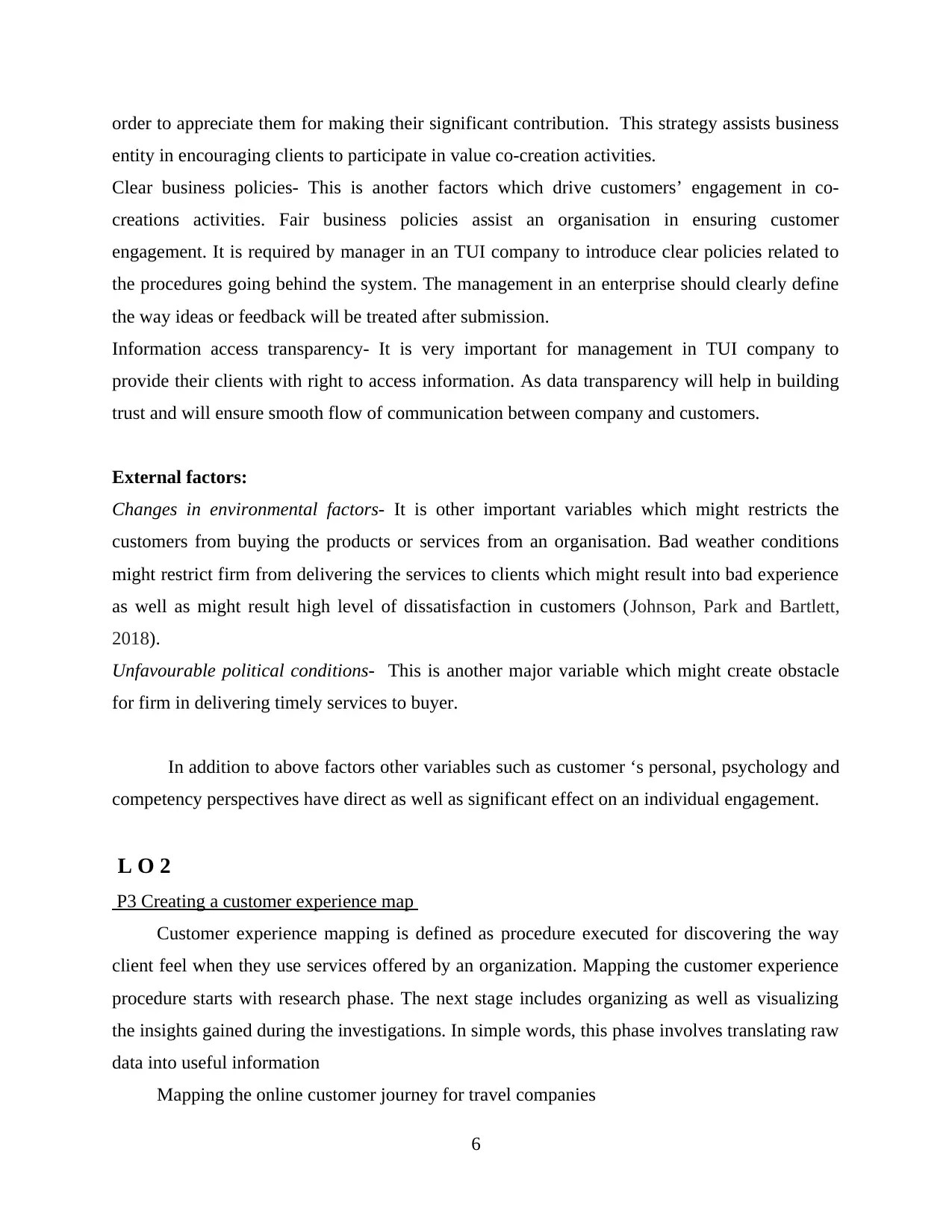
order to appreciate them for making their significant contribution. This strategy assists business
entity in encouraging clients to participate in value co-creation activities.
Clear business policies- This is another factors which drive customers’ engagement in co-
creations activities. Fair business policies assist an organisation in ensuring customer
engagement. It is required by manager in an TUI company to introduce clear policies related to
the procedures going behind the system. The management in an enterprise should clearly define
the way ideas or feedback will be treated after submission.
Information access transparency- It is very important for management in TUI company to
provide their clients with right to access information. As data transparency will help in building
trust and will ensure smooth flow of communication between company and customers.
External factors:
Changes in environmental factors- It is other important variables which might restricts the
customers from buying the products or services from an organisation. Bad weather conditions
might restrict firm from delivering the services to clients which might result into bad experience
as well as might result high level of dissatisfaction in customers (Johnson, Park and Bartlett,
2018).
Unfavourable political conditions- This is another major variable which might create obstacle
for firm in delivering timely services to buyer.
In addition to above factors other variables such as customer ‘s personal, psychology and
competency perspectives have direct as well as significant effect on an individual engagement.
L O 2
P3 Creating a customer experience map
Customer experience mapping is defined as procedure executed for discovering the way
client feel when they use services offered by an organization. Mapping the customer experience
procedure starts with research phase. The next stage includes organizing as well as visualizing
the insights gained during the investigations. In simple words, this phase involves translating raw
data into useful information
Mapping the online customer journey for travel companies
6
entity in encouraging clients to participate in value co-creation activities.
Clear business policies- This is another factors which drive customers’ engagement in co-
creations activities. Fair business policies assist an organisation in ensuring customer
engagement. It is required by manager in an TUI company to introduce clear policies related to
the procedures going behind the system. The management in an enterprise should clearly define
the way ideas or feedback will be treated after submission.
Information access transparency- It is very important for management in TUI company to
provide their clients with right to access information. As data transparency will help in building
trust and will ensure smooth flow of communication between company and customers.
External factors:
Changes in environmental factors- It is other important variables which might restricts the
customers from buying the products or services from an organisation. Bad weather conditions
might restrict firm from delivering the services to clients which might result into bad experience
as well as might result high level of dissatisfaction in customers (Johnson, Park and Bartlett,
2018).
Unfavourable political conditions- This is another major variable which might create obstacle
for firm in delivering timely services to buyer.
In addition to above factors other variables such as customer ‘s personal, psychology and
competency perspectives have direct as well as significant effect on an individual engagement.
L O 2
P3 Creating a customer experience map
Customer experience mapping is defined as procedure executed for discovering the way
client feel when they use services offered by an organization. Mapping the customer experience
procedure starts with research phase. The next stage includes organizing as well as visualizing
the insights gained during the investigations. In simple words, this phase involves translating raw
data into useful information
Mapping the online customer journey for travel companies
6
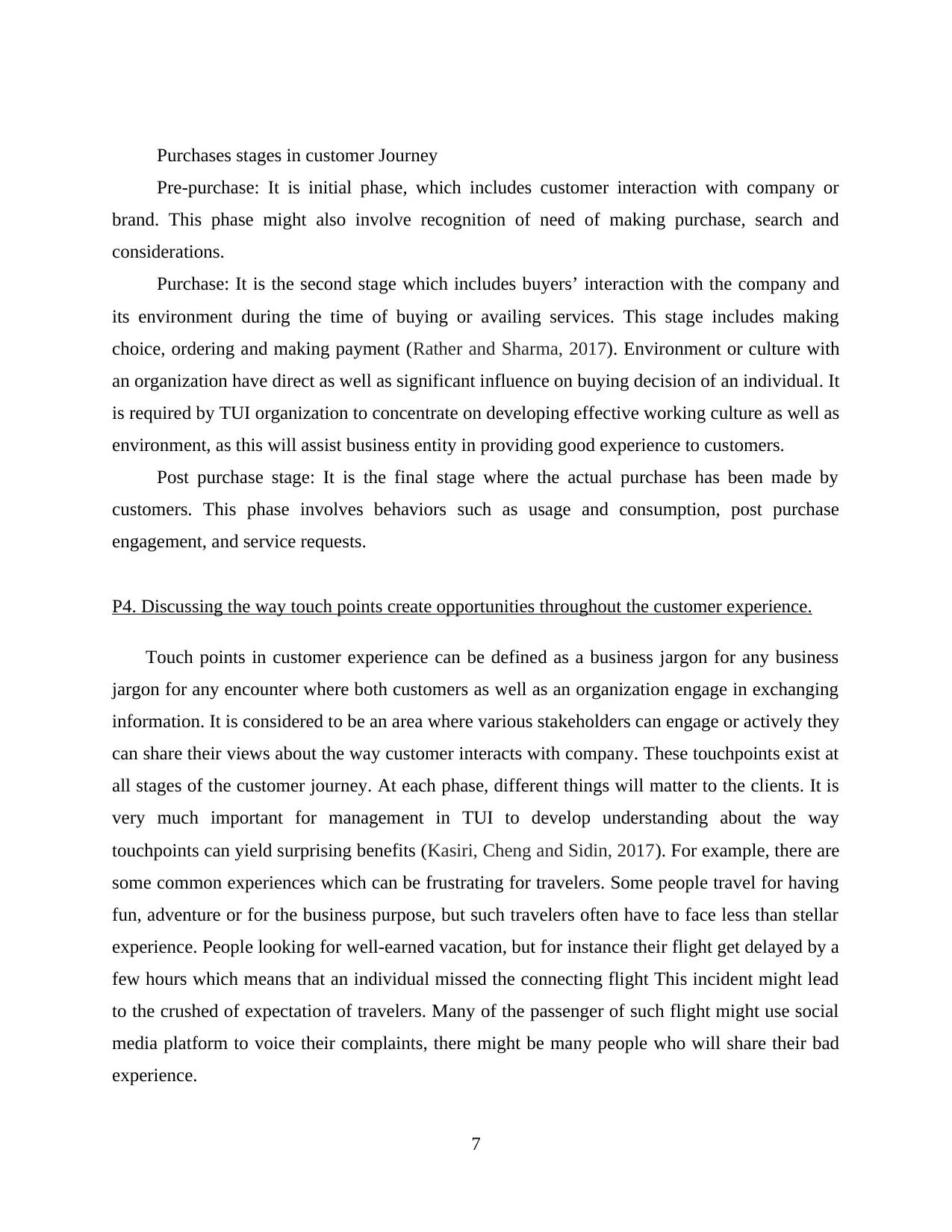
Purchases stages in customer Journey
Pre-purchase: It is initial phase, which includes customer interaction with company or
brand. This phase might also involve recognition of need of making purchase, search and
considerations.
Purchase: It is the second stage which includes buyers’ interaction with the company and
its environment during the time of buying or availing services. This stage includes making
choice, ordering and making payment (Rather and Sharma, 2017). Environment or culture with
an organization have direct as well as significant influence on buying decision of an individual. It
is required by TUI organization to concentrate on developing effective working culture as well as
environment, as this will assist business entity in providing good experience to customers.
Post purchase stage: It is the final stage where the actual purchase has been made by
customers. This phase involves behaviors such as usage and consumption, post purchase
engagement, and service requests.
P4. Discussing the way touch points create opportunities throughout the customer experience.
Touch points in customer experience can be defined as a business jargon for any business
jargon for any encounter where both customers as well as an organization engage in exchanging
information. It is considered to be an area where various stakeholders can engage or actively they
can share their views about the way customer interacts with company. These touchpoints exist at
all stages of the customer journey. At each phase, different things will matter to the clients. It is
very much important for management in TUI to develop understanding about the way
touchpoints can yield surprising benefits (Kasiri, Cheng and Sidin, 2017). For example, there are
some common experiences which can be frustrating for travelers. Some people travel for having
fun, adventure or for the business purpose, but such travelers often have to face less than stellar
experience. People looking for well-earned vacation, but for instance their flight get delayed by a
few hours which means that an individual missed the connecting flight This incident might lead
to the crushed of expectation of travelers. Many of the passenger of such flight might use social
media platform to voice their complaints, there might be many people who will share their bad
experience.
7
Pre-purchase: It is initial phase, which includes customer interaction with company or
brand. This phase might also involve recognition of need of making purchase, search and
considerations.
Purchase: It is the second stage which includes buyers’ interaction with the company and
its environment during the time of buying or availing services. This stage includes making
choice, ordering and making payment (Rather and Sharma, 2017). Environment or culture with
an organization have direct as well as significant influence on buying decision of an individual. It
is required by TUI organization to concentrate on developing effective working culture as well as
environment, as this will assist business entity in providing good experience to customers.
Post purchase stage: It is the final stage where the actual purchase has been made by
customers. This phase involves behaviors such as usage and consumption, post purchase
engagement, and service requests.
P4. Discussing the way touch points create opportunities throughout the customer experience.
Touch points in customer experience can be defined as a business jargon for any business
jargon for any encounter where both customers as well as an organization engage in exchanging
information. It is considered to be an area where various stakeholders can engage or actively they
can share their views about the way customer interacts with company. These touchpoints exist at
all stages of the customer journey. At each phase, different things will matter to the clients. It is
very much important for management in TUI to develop understanding about the way
touchpoints can yield surprising benefits (Kasiri, Cheng and Sidin, 2017). For example, there are
some common experiences which can be frustrating for travelers. Some people travel for having
fun, adventure or for the business purpose, but such travelers often have to face less than stellar
experience. People looking for well-earned vacation, but for instance their flight get delayed by a
few hours which means that an individual missed the connecting flight This incident might lead
to the crushed of expectation of travelers. Many of the passenger of such flight might use social
media platform to voice their complaints, there might be many people who will share their bad
experience.
7
Paraphrase This Document
Need a fresh take? Get an instant paraphrase of this document with our AI Paraphraser
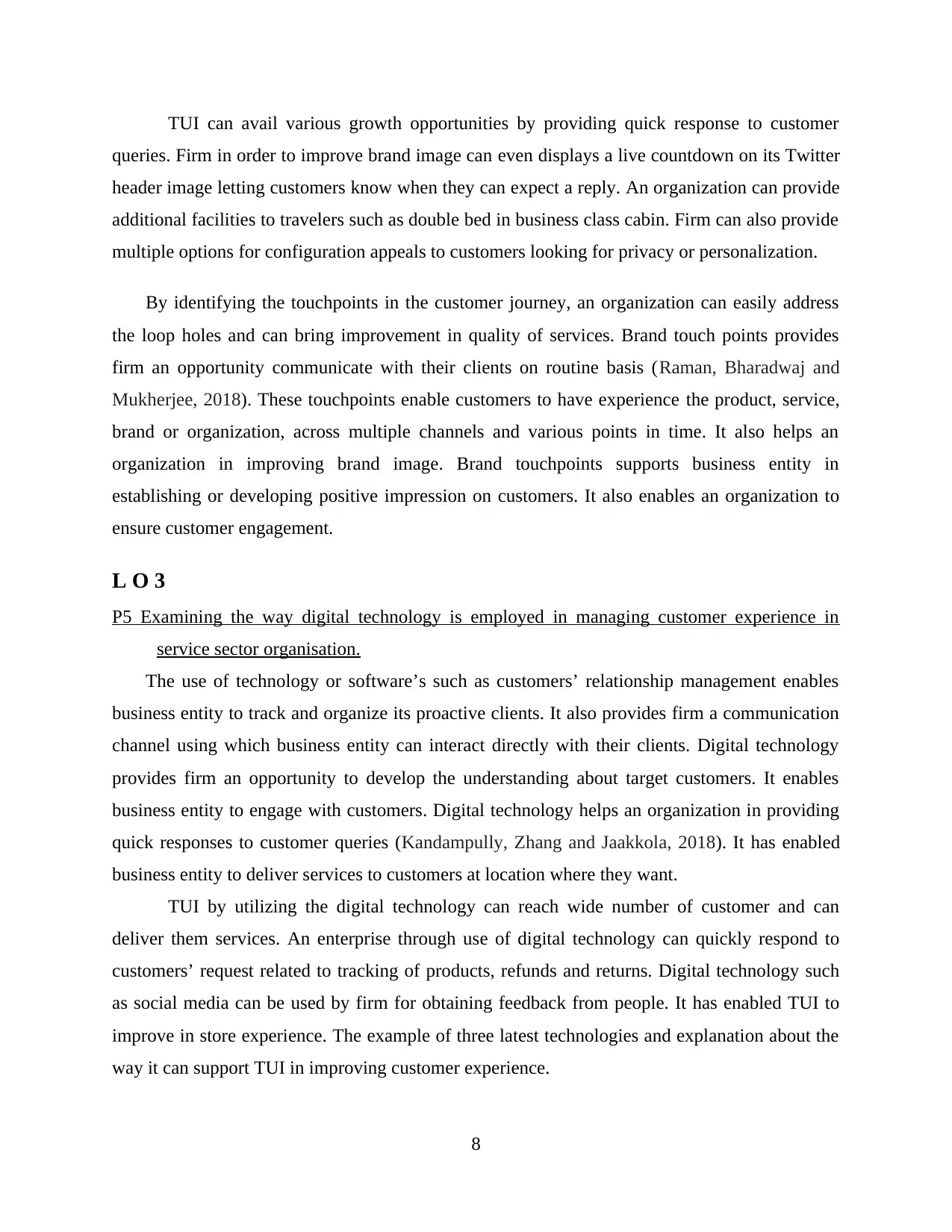
TUI can avail various growth opportunities by providing quick response to customer
queries. Firm in order to improve brand image can even displays a live countdown on its Twitter
header image letting customers know when they can expect a reply. An organization can provide
additional facilities to travelers such as double bed in business class cabin. Firm can also provide
multiple options for configuration appeals to customers looking for privacy or personalization.
By identifying the touchpoints in the customer journey, an organization can easily address
the loop holes and can bring improvement in quality of services. Brand touch points provides
firm an opportunity communicate with their clients on routine basis (Raman, Bharadwaj and
Mukherjee, 2018). These touchpoints enable customers to have experience the product, service,
brand or organization, across multiple channels and various points in time. It also helps an
organization in improving brand image. Brand touchpoints supports business entity in
establishing or developing positive impression on customers. It also enables an organization to
ensure customer engagement.
L O 3
P5 Examining the way digital technology is employed in managing customer experience in
service sector organisation.
The use of technology or software’s such as customers’ relationship management enables
business entity to track and organize its proactive clients. It also provides firm a communication
channel using which business entity can interact directly with their clients. Digital technology
provides firm an opportunity to develop the understanding about target customers. It enables
business entity to engage with customers. Digital technology helps an organization in providing
quick responses to customer queries (Kandampully, Zhang and Jaakkola, 2018). It has enabled
business entity to deliver services to customers at location where they want.
TUI by utilizing the digital technology can reach wide number of customer and can
deliver them services. An enterprise through use of digital technology can quickly respond to
customers’ request related to tracking of products, refunds and returns. Digital technology such
as social media can be used by firm for obtaining feedback from people. It has enabled TUI to
improve in store experience. The example of three latest technologies and explanation about the
way it can support TUI in improving customer experience.
8
queries. Firm in order to improve brand image can even displays a live countdown on its Twitter
header image letting customers know when they can expect a reply. An organization can provide
additional facilities to travelers such as double bed in business class cabin. Firm can also provide
multiple options for configuration appeals to customers looking for privacy or personalization.
By identifying the touchpoints in the customer journey, an organization can easily address
the loop holes and can bring improvement in quality of services. Brand touch points provides
firm an opportunity communicate with their clients on routine basis (Raman, Bharadwaj and
Mukherjee, 2018). These touchpoints enable customers to have experience the product, service,
brand or organization, across multiple channels and various points in time. It also helps an
organization in improving brand image. Brand touchpoints supports business entity in
establishing or developing positive impression on customers. It also enables an organization to
ensure customer engagement.
L O 3
P5 Examining the way digital technology is employed in managing customer experience in
service sector organisation.
The use of technology or software’s such as customers’ relationship management enables
business entity to track and organize its proactive clients. It also provides firm a communication
channel using which business entity can interact directly with their clients. Digital technology
provides firm an opportunity to develop the understanding about target customers. It enables
business entity to engage with customers. Digital technology helps an organization in providing
quick responses to customer queries (Kandampully, Zhang and Jaakkola, 2018). It has enabled
business entity to deliver services to customers at location where they want.
TUI by utilizing the digital technology can reach wide number of customer and can
deliver them services. An enterprise through use of digital technology can quickly respond to
customers’ request related to tracking of products, refunds and returns. Digital technology such
as social media can be used by firm for obtaining feedback from people. It has enabled TUI to
improve in store experience. The example of three latest technologies and explanation about the
way it can support TUI in improving customer experience.
8
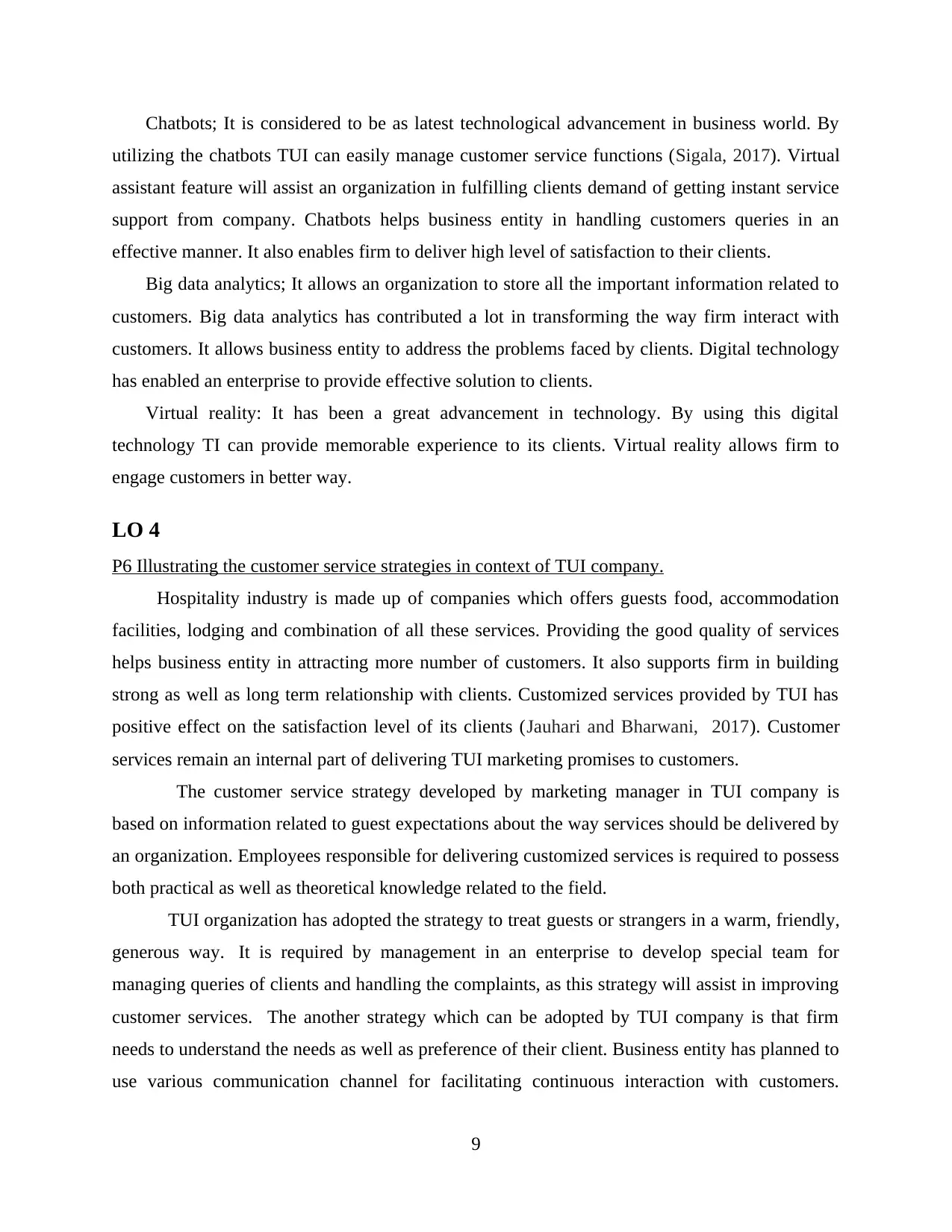
Chatbots; It is considered to be as latest technological advancement in business world. By
utilizing the chatbots TUI can easily manage customer service functions (Sigala, 2017). Virtual
assistant feature will assist an organization in fulfilling clients demand of getting instant service
support from company. Chatbots helps business entity in handling customers queries in an
effective manner. It also enables firm to deliver high level of satisfaction to their clients.
Big data analytics; It allows an organization to store all the important information related to
customers. Big data analytics has contributed a lot in transforming the way firm interact with
customers. It allows business entity to address the problems faced by clients. Digital technology
has enabled an enterprise to provide effective solution to clients.
Virtual reality: It has been a great advancement in technology. By using this digital
technology TI can provide memorable experience to its clients. Virtual reality allows firm to
engage customers in better way.
LO 4
P6 Illustrating the customer service strategies in context of TUI company.
Hospitality industry is made up of companies which offers guests food, accommodation
facilities, lodging and combination of all these services. Providing the good quality of services
helps business entity in attracting more number of customers. It also supports firm in building
strong as well as long term relationship with clients. Customized services provided by TUI has
positive effect on the satisfaction level of its clients (Jauhari and Bharwani, 2017). Customer
services remain an internal part of delivering TUI marketing promises to customers.
The customer service strategy developed by marketing manager in TUI company is
based on information related to guest expectations about the way services should be delivered by
an organization. Employees responsible for delivering customized services is required to possess
both practical as well as theoretical knowledge related to the field.
TUI organization has adopted the strategy to treat guests or strangers in a warm, friendly,
generous way. It is required by management in an enterprise to develop special team for
managing queries of clients and handling the complaints, as this strategy will assist in improving
customer services. The another strategy which can be adopted by TUI company is that firm
needs to understand the needs as well as preference of their client. Business entity has planned to
use various communication channel for facilitating continuous interaction with customers.
9
utilizing the chatbots TUI can easily manage customer service functions (Sigala, 2017). Virtual
assistant feature will assist an organization in fulfilling clients demand of getting instant service
support from company. Chatbots helps business entity in handling customers queries in an
effective manner. It also enables firm to deliver high level of satisfaction to their clients.
Big data analytics; It allows an organization to store all the important information related to
customers. Big data analytics has contributed a lot in transforming the way firm interact with
customers. It allows business entity to address the problems faced by clients. Digital technology
has enabled an enterprise to provide effective solution to clients.
Virtual reality: It has been a great advancement in technology. By using this digital
technology TI can provide memorable experience to its clients. Virtual reality allows firm to
engage customers in better way.
LO 4
P6 Illustrating the customer service strategies in context of TUI company.
Hospitality industry is made up of companies which offers guests food, accommodation
facilities, lodging and combination of all these services. Providing the good quality of services
helps business entity in attracting more number of customers. It also supports firm in building
strong as well as long term relationship with clients. Customized services provided by TUI has
positive effect on the satisfaction level of its clients (Jauhari and Bharwani, 2017). Customer
services remain an internal part of delivering TUI marketing promises to customers.
The customer service strategy developed by marketing manager in TUI company is
based on information related to guest expectations about the way services should be delivered by
an organization. Employees responsible for delivering customized services is required to possess
both practical as well as theoretical knowledge related to the field.
TUI organization has adopted the strategy to treat guests or strangers in a warm, friendly,
generous way. It is required by management in an enterprise to develop special team for
managing queries of clients and handling the complaints, as this strategy will assist in improving
customer services. The another strategy which can be adopted by TUI company is that firm
needs to understand the needs as well as preference of their client. Business entity has planned to
use various communication channel for facilitating continuous interaction with customers.
9
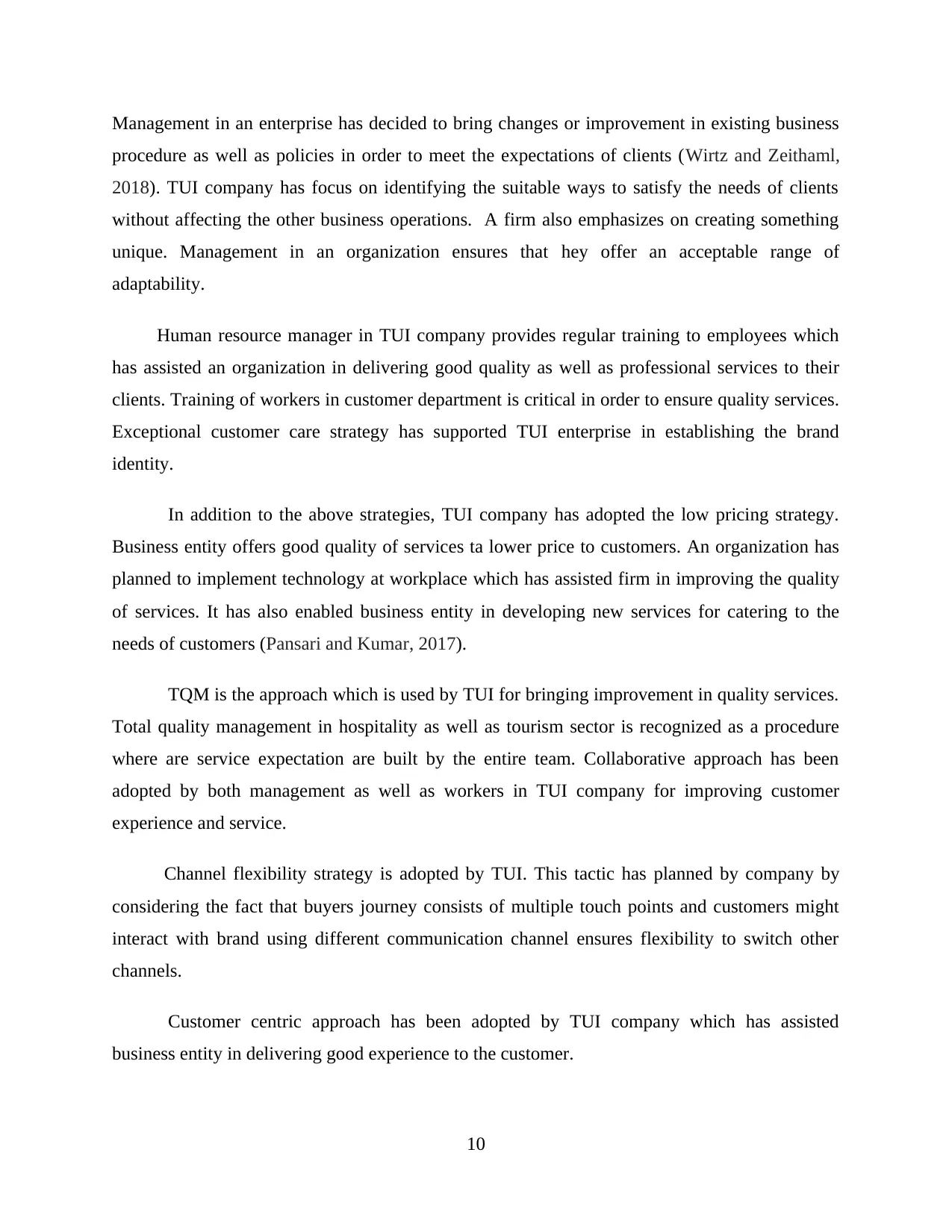
Management in an enterprise has decided to bring changes or improvement in existing business
procedure as well as policies in order to meet the expectations of clients (Wirtz and Zeithaml,
2018). TUI company has focus on identifying the suitable ways to satisfy the needs of clients
without affecting the other business operations. A firm also emphasizes on creating something
unique. Management in an organization ensures that hey offer an acceptable range of
adaptability.
Human resource manager in TUI company provides regular training to employees which
has assisted an organization in delivering good quality as well as professional services to their
clients. Training of workers in customer department is critical in order to ensure quality services.
Exceptional customer care strategy has supported TUI enterprise in establishing the brand
identity.
In addition to the above strategies, TUI company has adopted the low pricing strategy.
Business entity offers good quality of services ta lower price to customers. An organization has
planned to implement technology at workplace which has assisted firm in improving the quality
of services. It has also enabled business entity in developing new services for catering to the
needs of customers (Pansari and Kumar, 2017).
TQM is the approach which is used by TUI for bringing improvement in quality services.
Total quality management in hospitality as well as tourism sector is recognized as a procedure
where are service expectation are built by the entire team. Collaborative approach has been
adopted by both management as well as workers in TUI company for improving customer
experience and service.
Channel flexibility strategy is adopted by TUI. This tactic has planned by company by
considering the fact that buyers journey consists of multiple touch points and customers might
interact with brand using different communication channel ensures flexibility to switch other
channels.
Customer centric approach has been adopted by TUI company which has assisted
business entity in delivering good experience to the customer.
10
procedure as well as policies in order to meet the expectations of clients (Wirtz and Zeithaml,
2018). TUI company has focus on identifying the suitable ways to satisfy the needs of clients
without affecting the other business operations. A firm also emphasizes on creating something
unique. Management in an organization ensures that hey offer an acceptable range of
adaptability.
Human resource manager in TUI company provides regular training to employees which
has assisted an organization in delivering good quality as well as professional services to their
clients. Training of workers in customer department is critical in order to ensure quality services.
Exceptional customer care strategy has supported TUI enterprise in establishing the brand
identity.
In addition to the above strategies, TUI company has adopted the low pricing strategy.
Business entity offers good quality of services ta lower price to customers. An organization has
planned to implement technology at workplace which has assisted firm in improving the quality
of services. It has also enabled business entity in developing new services for catering to the
needs of customers (Pansari and Kumar, 2017).
TQM is the approach which is used by TUI for bringing improvement in quality services.
Total quality management in hospitality as well as tourism sector is recognized as a procedure
where are service expectation are built by the entire team. Collaborative approach has been
adopted by both management as well as workers in TUI company for improving customer
experience and service.
Channel flexibility strategy is adopted by TUI. This tactic has planned by company by
considering the fact that buyers journey consists of multiple touch points and customers might
interact with brand using different communication channel ensures flexibility to switch other
channels.
Customer centric approach has been adopted by TUI company which has assisted
business entity in delivering good experience to the customer.
10
Secure Best Marks with AI Grader
Need help grading? Try our AI Grader for instant feedback on your assignments.
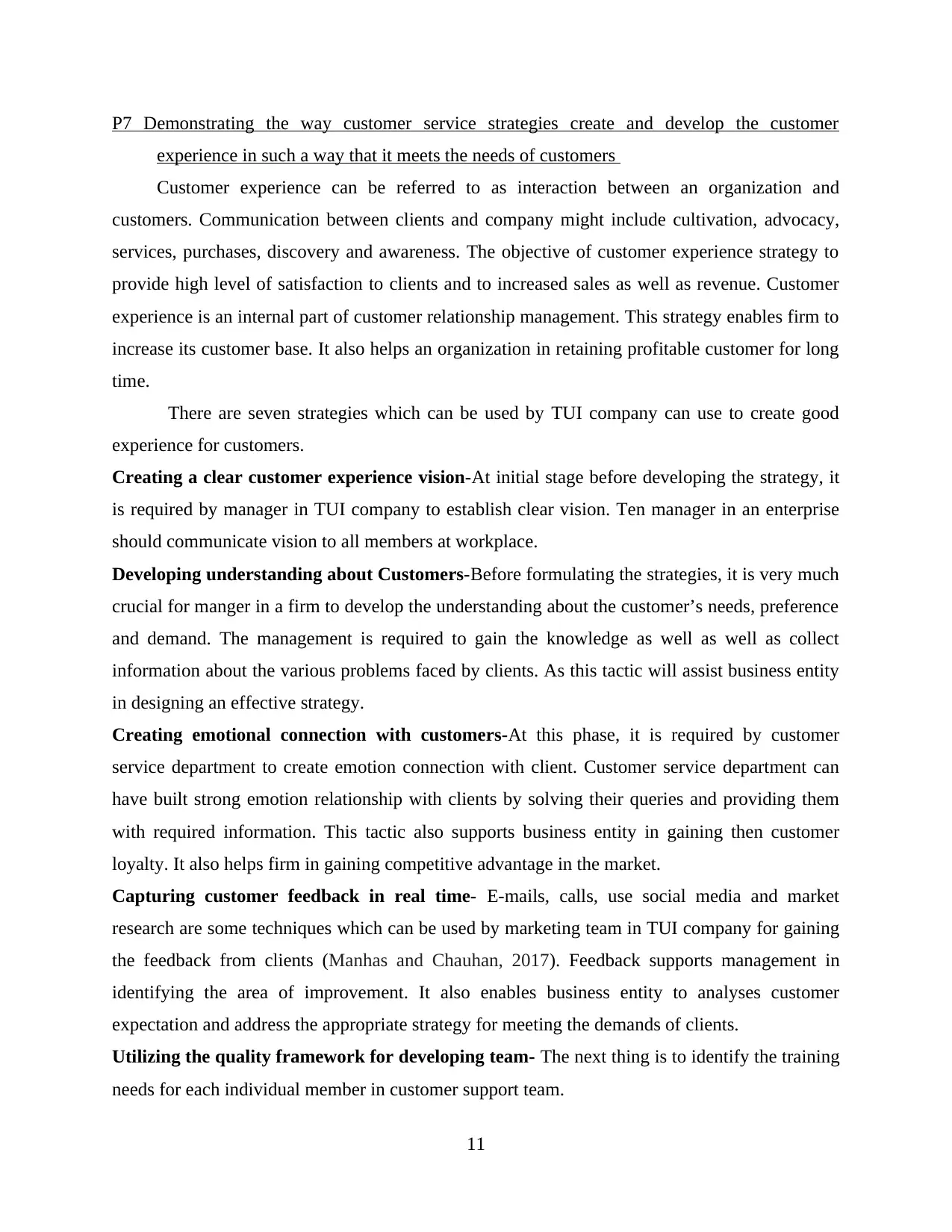
P7 Demonstrating the way customer service strategies create and develop the customer
experience in such a way that it meets the needs of customers
Customer experience can be referred to as interaction between an organization and
customers. Communication between clients and company might include cultivation, advocacy,
services, purchases, discovery and awareness. The objective of customer experience strategy to
provide high level of satisfaction to clients and to increased sales as well as revenue. Customer
experience is an internal part of customer relationship management. This strategy enables firm to
increase its customer base. It also helps an organization in retaining profitable customer for long
time.
There are seven strategies which can be used by TUI company can use to create good
experience for customers.
Creating a clear customer experience vision-At initial stage before developing the strategy, it
is required by manager in TUI company to establish clear vision. Ten manager in an enterprise
should communicate vision to all members at workplace.
Developing understanding about Customers-Before formulating the strategies, it is very much
crucial for manger in a firm to develop the understanding about the customer’s needs, preference
and demand. The management is required to gain the knowledge as well as well as collect
information about the various problems faced by clients. As this tactic will assist business entity
in designing an effective strategy.
Creating emotional connection with customers-At this phase, it is required by customer
service department to create emotion connection with client. Customer service department can
have built strong emotion relationship with clients by solving their queries and providing them
with required information. This tactic also supports business entity in gaining then customer
loyalty. It also helps firm in gaining competitive advantage in the market.
Capturing customer feedback in real time- E-mails, calls, use social media and market
research are some techniques which can be used by marketing team in TUI company for gaining
the feedback from clients (Manhas and Chauhan, 2017). Feedback supports management in
identifying the area of improvement. It also enables business entity to analyses customer
expectation and address the appropriate strategy for meeting the demands of clients.
Utilizing the quality framework for developing team- The next thing is to identify the training
needs for each individual member in customer support team.
11
experience in such a way that it meets the needs of customers
Customer experience can be referred to as interaction between an organization and
customers. Communication between clients and company might include cultivation, advocacy,
services, purchases, discovery and awareness. The objective of customer experience strategy to
provide high level of satisfaction to clients and to increased sales as well as revenue. Customer
experience is an internal part of customer relationship management. This strategy enables firm to
increase its customer base. It also helps an organization in retaining profitable customer for long
time.
There are seven strategies which can be used by TUI company can use to create good
experience for customers.
Creating a clear customer experience vision-At initial stage before developing the strategy, it
is required by manager in TUI company to establish clear vision. Ten manager in an enterprise
should communicate vision to all members at workplace.
Developing understanding about Customers-Before formulating the strategies, it is very much
crucial for manger in a firm to develop the understanding about the customer’s needs, preference
and demand. The management is required to gain the knowledge as well as well as collect
information about the various problems faced by clients. As this tactic will assist business entity
in designing an effective strategy.
Creating emotional connection with customers-At this phase, it is required by customer
service department to create emotion connection with client. Customer service department can
have built strong emotion relationship with clients by solving their queries and providing them
with required information. This tactic also supports business entity in gaining then customer
loyalty. It also helps firm in gaining competitive advantage in the market.
Capturing customer feedback in real time- E-mails, calls, use social media and market
research are some techniques which can be used by marketing team in TUI company for gaining
the feedback from clients (Manhas and Chauhan, 2017). Feedback supports management in
identifying the area of improvement. It also enables business entity to analyses customer
expectation and address the appropriate strategy for meeting the demands of clients.
Utilizing the quality framework for developing team- The next thing is to identify the training
needs for each individual member in customer support team.
11
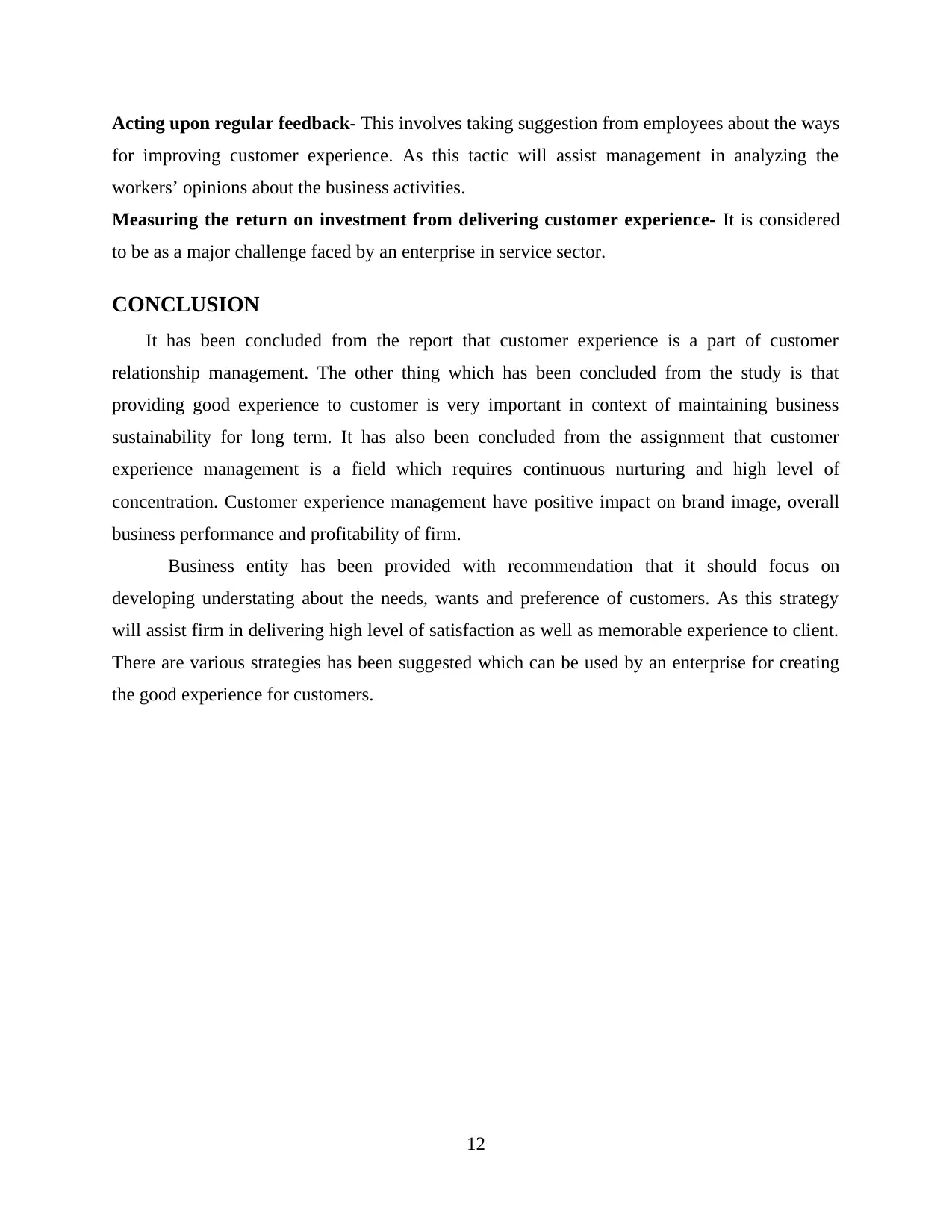
Acting upon regular feedback- This involves taking suggestion from employees about the ways
for improving customer experience. As this tactic will assist management in analyzing the
workers’ opinions about the business activities.
Measuring the return on investment from delivering customer experience- It is considered
to be as a major challenge faced by an enterprise in service sector.
CONCLUSION
It has been concluded from the report that customer experience is a part of customer
relationship management. The other thing which has been concluded from the study is that
providing good experience to customer is very important in context of maintaining business
sustainability for long term. It has also been concluded from the assignment that customer
experience management is a field which requires continuous nurturing and high level of
concentration. Customer experience management have positive impact on brand image, overall
business performance and profitability of firm.
Business entity has been provided with recommendation that it should focus on
developing understating about the needs, wants and preference of customers. As this strategy
will assist firm in delivering high level of satisfaction as well as memorable experience to client.
There are various strategies has been suggested which can be used by an enterprise for creating
the good experience for customers.
12
for improving customer experience. As this tactic will assist management in analyzing the
workers’ opinions about the business activities.
Measuring the return on investment from delivering customer experience- It is considered
to be as a major challenge faced by an enterprise in service sector.
CONCLUSION
It has been concluded from the report that customer experience is a part of customer
relationship management. The other thing which has been concluded from the study is that
providing good experience to customer is very important in context of maintaining business
sustainability for long term. It has also been concluded from the assignment that customer
experience management is a field which requires continuous nurturing and high level of
concentration. Customer experience management have positive impact on brand image, overall
business performance and profitability of firm.
Business entity has been provided with recommendation that it should focus on
developing understating about the needs, wants and preference of customers. As this strategy
will assist firm in delivering high level of satisfaction as well as memorable experience to client.
There are various strategies has been suggested which can be used by an enterprise for creating
the good experience for customers.
12
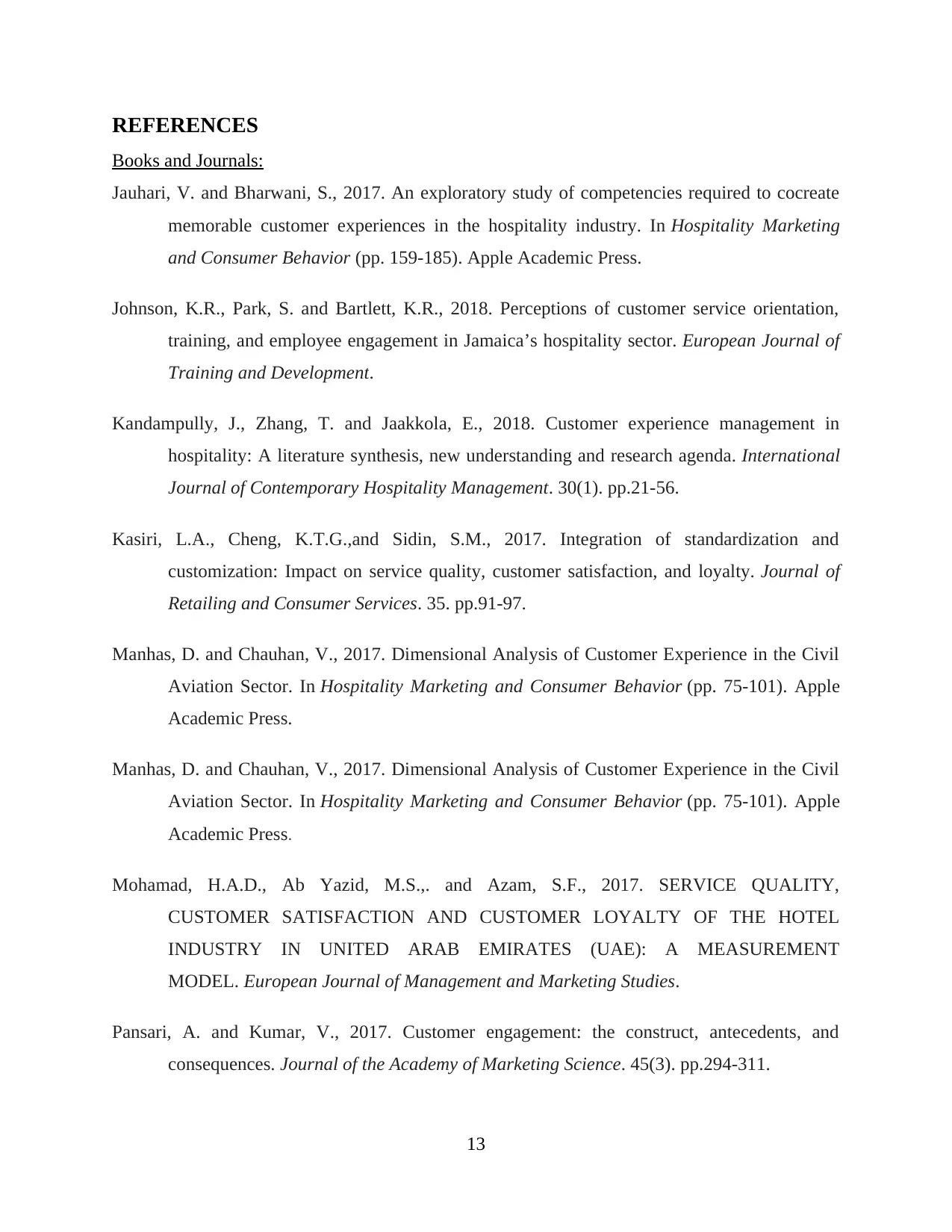
REFERENCES
Books and Journals:
Jauhari, V. and Bharwani, S., 2017. An exploratory study of competencies required to cocreate
memorable customer experiences in the hospitality industry. In Hospitality Marketing
and Consumer Behavior (pp. 159-185). Apple Academic Press.
Johnson, K.R., Park, S. and Bartlett, K.R., 2018. Perceptions of customer service orientation,
training, and employee engagement in Jamaica’s hospitality sector. European Journal of
Training and Development.
Kandampully, J., Zhang, T. and Jaakkola, E., 2018. Customer experience management in
hospitality: A literature synthesis, new understanding and research agenda. International
Journal of Contemporary Hospitality Management. 30(1). pp.21-56.
Kasiri, L.A., Cheng, K.T.G.,and Sidin, S.M., 2017. Integration of standardization and
customization: Impact on service quality, customer satisfaction, and loyalty. Journal of
Retailing and Consumer Services. 35. pp.91-97.
Manhas, D. and Chauhan, V., 2017. Dimensional Analysis of Customer Experience in the Civil
Aviation Sector. In Hospitality Marketing and Consumer Behavior (pp. 75-101). Apple
Academic Press.
Manhas, D. and Chauhan, V., 2017. Dimensional Analysis of Customer Experience in the Civil
Aviation Sector. In Hospitality Marketing and Consumer Behavior (pp. 75-101). Apple
Academic Press.
Mohamad, H.A.D., Ab Yazid, M.S.,. and Azam, S.F., 2017. SERVICE QUALITY,
CUSTOMER SATISFACTION AND CUSTOMER LOYALTY OF THE HOTEL
INDUSTRY IN UNITED ARAB EMIRATES (UAE): A MEASUREMENT
MODEL. European Journal of Management and Marketing Studies.
Pansari, A. and Kumar, V., 2017. Customer engagement: the construct, antecedents, and
consequences. Journal of the Academy of Marketing Science. 45(3). pp.294-311.
13
Books and Journals:
Jauhari, V. and Bharwani, S., 2017. An exploratory study of competencies required to cocreate
memorable customer experiences in the hospitality industry. In Hospitality Marketing
and Consumer Behavior (pp. 159-185). Apple Academic Press.
Johnson, K.R., Park, S. and Bartlett, K.R., 2018. Perceptions of customer service orientation,
training, and employee engagement in Jamaica’s hospitality sector. European Journal of
Training and Development.
Kandampully, J., Zhang, T. and Jaakkola, E., 2018. Customer experience management in
hospitality: A literature synthesis, new understanding and research agenda. International
Journal of Contemporary Hospitality Management. 30(1). pp.21-56.
Kasiri, L.A., Cheng, K.T.G.,and Sidin, S.M., 2017. Integration of standardization and
customization: Impact on service quality, customer satisfaction, and loyalty. Journal of
Retailing and Consumer Services. 35. pp.91-97.
Manhas, D. and Chauhan, V., 2017. Dimensional Analysis of Customer Experience in the Civil
Aviation Sector. In Hospitality Marketing and Consumer Behavior (pp. 75-101). Apple
Academic Press.
Manhas, D. and Chauhan, V., 2017. Dimensional Analysis of Customer Experience in the Civil
Aviation Sector. In Hospitality Marketing and Consumer Behavior (pp. 75-101). Apple
Academic Press.
Mohamad, H.A.D., Ab Yazid, M.S.,. and Azam, S.F., 2017. SERVICE QUALITY,
CUSTOMER SATISFACTION AND CUSTOMER LOYALTY OF THE HOTEL
INDUSTRY IN UNITED ARAB EMIRATES (UAE): A MEASUREMENT
MODEL. European Journal of Management and Marketing Studies.
Pansari, A. and Kumar, V., 2017. Customer engagement: the construct, antecedents, and
consequences. Journal of the Academy of Marketing Science. 45(3). pp.294-311.
13
Paraphrase This Document
Need a fresh take? Get an instant paraphrase of this document with our AI Paraphraser
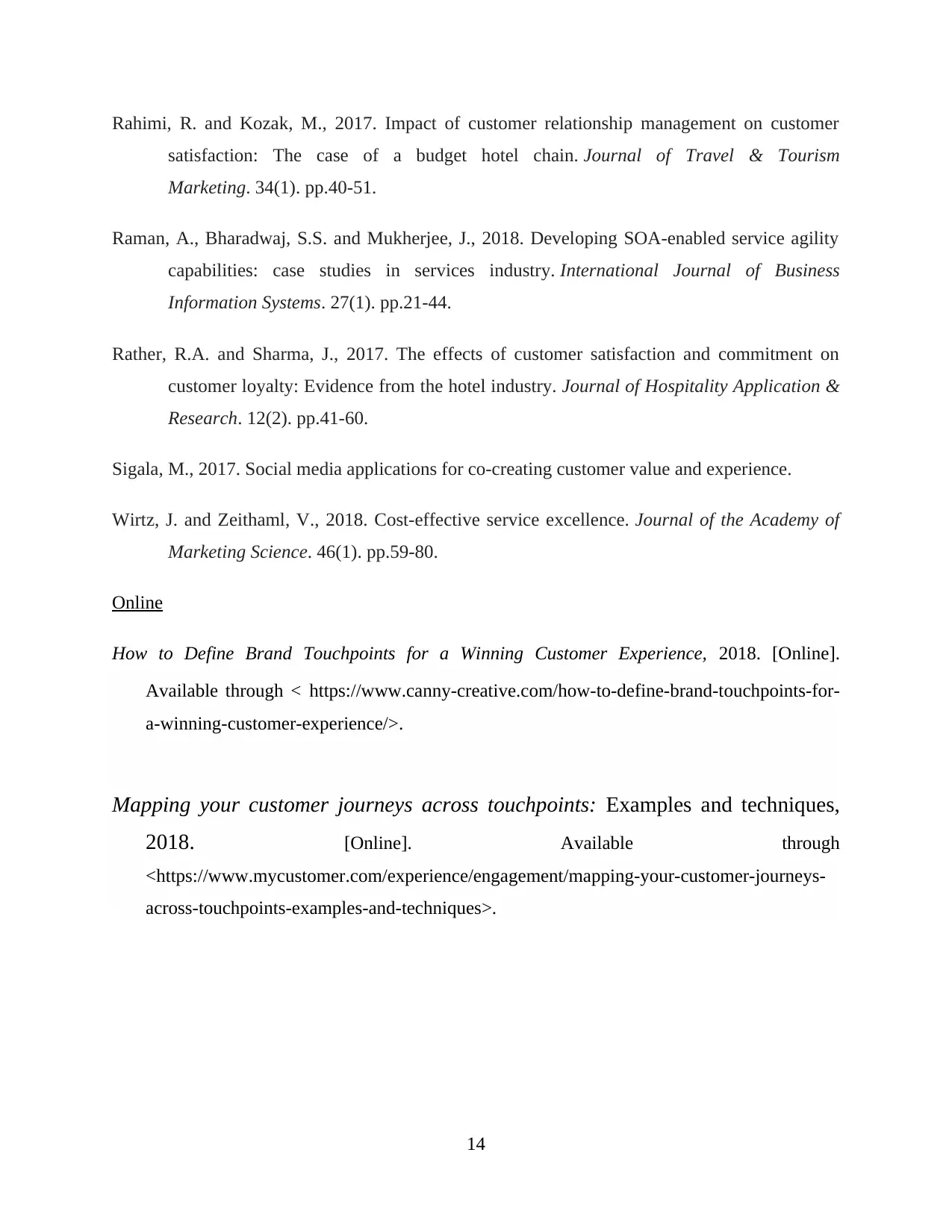
Rahimi, R. and Kozak, M., 2017. Impact of customer relationship management on customer
satisfaction: The case of a budget hotel chain. Journal of Travel & Tourism
Marketing. 34(1). pp.40-51.
Raman, A., Bharadwaj, S.S. and Mukherjee, J., 2018. Developing SOA-enabled service agility
capabilities: case studies in services industry. International Journal of Business
Information Systems. 27(1). pp.21-44.
Rather, R.A. and Sharma, J., 2017. The effects of customer satisfaction and commitment on
customer loyalty: Evidence from the hotel industry. Journal of Hospitality Application &
Research. 12(2). pp.41-60.
Sigala, M., 2017. Social media applications for co-creating customer value and experience.
Wirtz, J. and Zeithaml, V., 2018. Cost-effective service excellence. Journal of the Academy of
Marketing Science. 46(1). pp.59-80.
Online
How to Define Brand Touchpoints for a Winning Customer Experience, 2018. [Online].
Available through < https://www.canny-creative.com/how-to-define-brand-touchpoints-for-
a-winning-customer-experience/>.
Mapping your customer journeys across touchpoints: Examples and techniques,
2018. [Online]. Available through
<https://www.mycustomer.com/experience/engagement/mapping-your-customer-journeys-
across-touchpoints-examples-and-techniques>.
14
satisfaction: The case of a budget hotel chain. Journal of Travel & Tourism
Marketing. 34(1). pp.40-51.
Raman, A., Bharadwaj, S.S. and Mukherjee, J., 2018. Developing SOA-enabled service agility
capabilities: case studies in services industry. International Journal of Business
Information Systems. 27(1). pp.21-44.
Rather, R.A. and Sharma, J., 2017. The effects of customer satisfaction and commitment on
customer loyalty: Evidence from the hotel industry. Journal of Hospitality Application &
Research. 12(2). pp.41-60.
Sigala, M., 2017. Social media applications for co-creating customer value and experience.
Wirtz, J. and Zeithaml, V., 2018. Cost-effective service excellence. Journal of the Academy of
Marketing Science. 46(1). pp.59-80.
Online
How to Define Brand Touchpoints for a Winning Customer Experience, 2018. [Online].
Available through < https://www.canny-creative.com/how-to-define-brand-touchpoints-for-
a-winning-customer-experience/>.
Mapping your customer journeys across touchpoints: Examples and techniques,
2018. [Online]. Available through
<https://www.mycustomer.com/experience/engagement/mapping-your-customer-journeys-
across-touchpoints-examples-and-techniques>.
14
1 out of 14
Related Documents
Your All-in-One AI-Powered Toolkit for Academic Success.
+13062052269
info@desklib.com
Available 24*7 on WhatsApp / Email
![[object Object]](/_next/static/media/star-bottom.7253800d.svg)
Unlock your academic potential
© 2024 | Zucol Services PVT LTD | All rights reserved.





